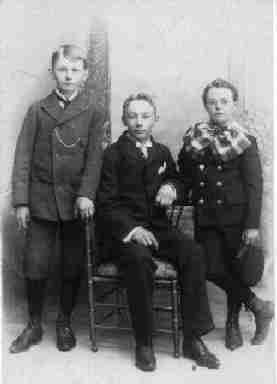
Family Outfits: Differences

Figure 1.--The clothes worn by these boys have been carefully tailored to their ages, presumably by mother. The oldest boy wears a long pants suit. The middle boy wears a similar suit, but with knickers like his younger brother. The younger boy wears a big floppy bow.
|
Mothers faced the decission of how to dress their children. This could prove quite complicated in a large family as was common in the 19th century. One fashion popular with mothers was to dress brothers and sisters in identical or coordinated outfits. Some mothers took a different approach and chose to vary the childrens outfits. The outfits could be varied by gender or age or both.
Mothers in the 19th century had much more lattitude on how to dress their children. Society did not have the relatively strict conventions that we have today. The children themselves had little to say in the matter. We know from autobiographies that they had their opinions on such matters and would tease other boys about theclothes they had to wear, but they had little say on what their mothers chose for them. Some sould ask their fathers to intervene, but this would only be older boys. In most families mother was the final arbriter.
Some individual images offer interesting insights into 19th Century
families and the clothing chosen by mothers in that period. Unfortunately
usually information on the families is not available, only the image
is available.
Age Distinctions
Some mothers while choosing identical or similar styles for the children allowed age destinctions of various types. This varies greatly from family to family and there were many different approaches.
Major age groupings
A mother with a large family might group the children. Some might be dresses in dresses or kilts. Older boys might wear sailor suits while the oldest boys might war proper suits, at first with kneepants. The boys in the different groups might be dressed identically until they graduated to the next group. Or the mother might make small differences for the older boy in each group. Then ther was the decisiion of when to move the next style. The boys coud all be moved at the same time, or individually as they reach a specified age.
Individual staggered differences
Some mothers chose to dress each child differently. Thus in a family outfits might range from dresses, kilts, Fauntleroy suits, Buster Brown suits, Russian tunics, sailor suits, and kneepants or long pants suits, among a host of other alternatives. This was a particularrly popular approach for the thrifty mother who could pass on an outgrown style to the younger brother.
Incremental differences
Some mothers chose to dress their children similarly, if not in identical outfits. Thus younger boys still in dresses might have small differences. The yonger boy might wear a dress like his sisters' while a slightly older boy might war a boys' styled dress or a kilt. Yomger boys might wear pantalettes. Once a boy graduated to kilt suits major changes could be made in appearance like changing the collar and bow. A younger boybmight wear a large frilly collar and floppy bow and as he got older a these could be replaced with more mature collars and bows. The same approach could be taken with suits. The first suit would be a kneepants or knicker suit which coyld be eventually replaced with long pants. Head gear and hair styles were also use to establish age differences. Younger boys might wear wide-brimmed sailor hats with streamers which could be gradually replaced with more mature styles. The long, sometimes, curled hair of the younger boy could be gradually cropped as a boy matured. Thus in a large family there could be a wide range of hair styles. Interestingly, however, there were generally much more difference in clothes then in hair styles. Often, but not alwys, many families had one hair style for boys once their curls were cut.

Figure 2.--.
|
Gender Differences
The clothes worn by children were also commonly varied by gender. In some cases their might be no age destinctions, only gender differences. The most common appraoch was once the children emerged from dresses that they then wore styles based on gender and then differentiated by age. The younger children, both boys and girls, could all wear dresses. Other outfits could be coordinated like middy blouses with the boys wearing kneepants and the girls skirts, thus gendr differences did not always disrupt the age groupings.
Thus
Christopher Wagner
histclo@lycosmail.com
Navigate the Boys' Historical Clothing Web Site:
[Return to the Main family style page]
[Return to the Main family clothing decission page]
[Introduction]
[Chronolo gy]
[Clothing styles]
[Biographies]
[Bibliographies]
[Activities]
[Countries]
[FAQs]
[Fashion messages]
[Contributions]
[Boys' Clothing Home]
Created: October 19, 1999
Last updated: October 20, 1999



